Comprehensive Analysis and Critical Text
Contemporary Art Station International Cultural Management, SL
Spain — 2024
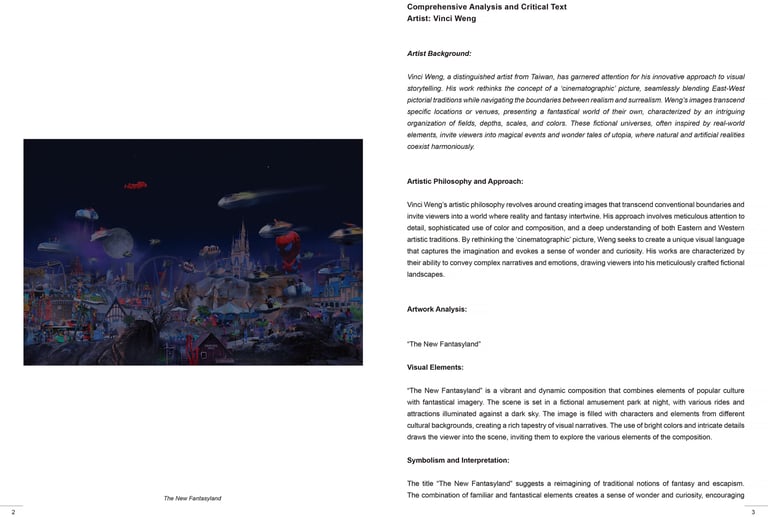

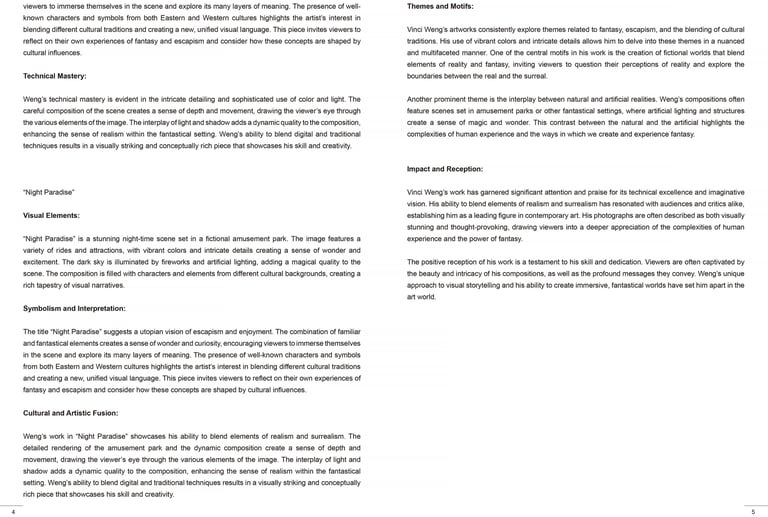

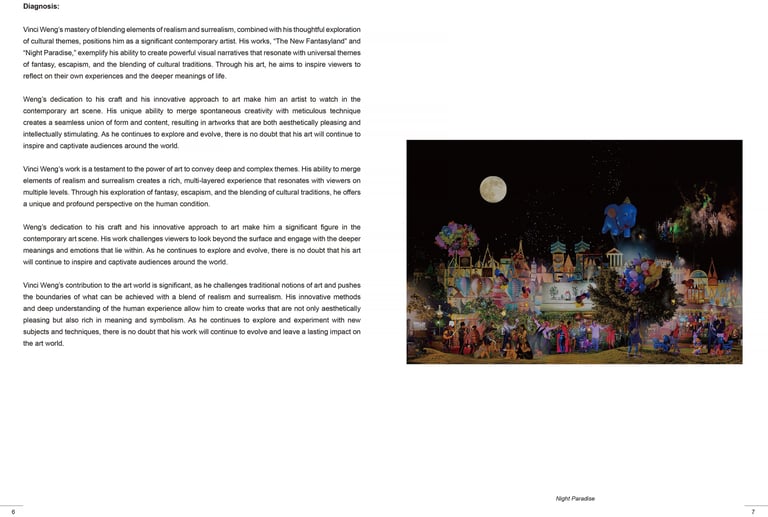


The Woven Tale Press the literary and visual arts magazine
Pages 35~42 | Spring 2022 ISSN:2469-5475
New York — 2022
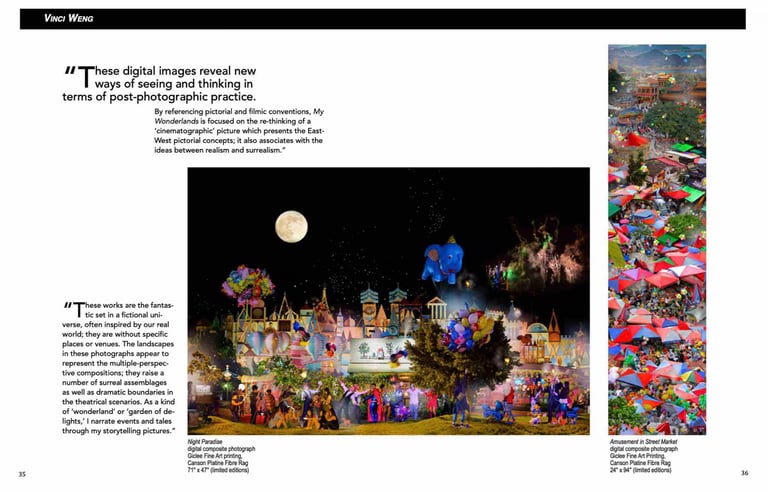

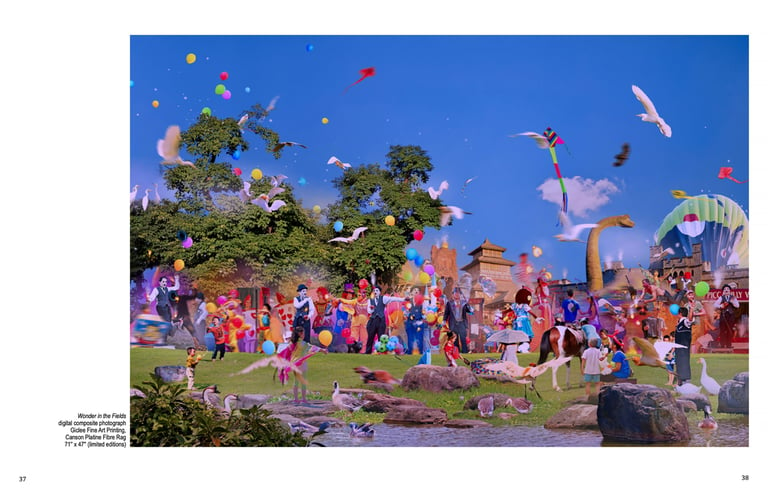

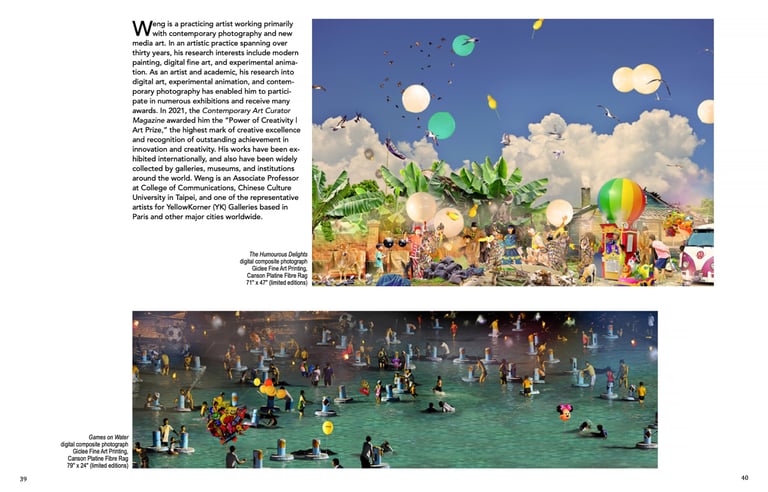

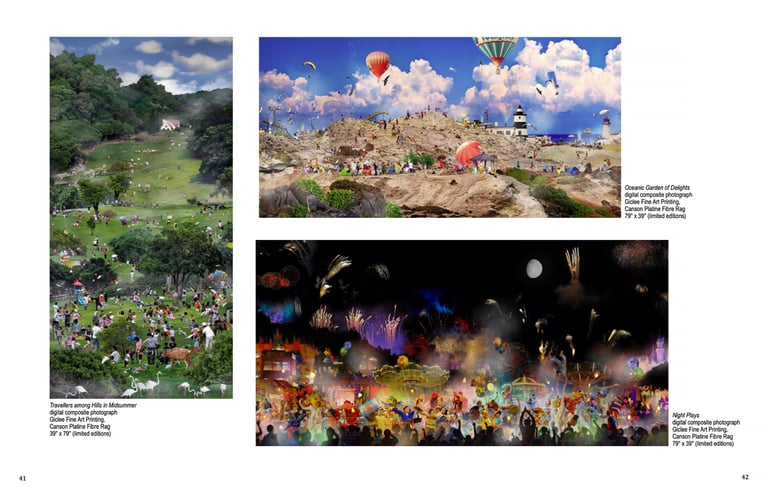


The Secular Garden of Delight
Text by Prof. Oscar Ho Hing-kay Adjunct Associate Professor Department of Cultural and Religious Studies The Chinese University of Hong Kong
Formerly Exhibition Director at the Hong Kong Arts Centre, Senior Research Officer at the Home Affairs Bureau of the Hong Kong Government, and Founding Director of the Museum of Contemporary Art, Shanghai.
Vinci Weng’s three photographic works – Amusement in the Street Market, Travellers among Hills in Midsummer, and A Wonderful Picnic – all present vibrant scenes reminiscent of temple fair celebrations, viewed from an elevated perspective. These images evoke the communal landscapes of Along the River During the Qingming Festival, teeming with lively, animated figures.
The latter two works depict family outings and countryside picnics, with both their form and content reflecting a distinctly middle-class sensibility. In contrast, the colourful Amusement in the Street Market conveys stronger grassroots, working-class atmosphere. While all three compositions are constructed through recombination and collage, the resulting virtual or artificial effect remains relatively understated.
At first glance, Travellers among Hills in Midsummer and A Wonderful Picnic call to mind the renowned 15th-century Dutch painter Hieronymus Bosch’s masterpiece The Garden of Earthly Delights. Set in expansive landscapes, people of all ages – men, women, and children – are shown at leisure among various animals, creating a deliberately staged vision of human interaction with nature. However, these scenes are devoid of any overt critique, and certainly lack the apocalyptic religious warnings found in Bosch’s Garden.
Weng displays considerable maturity in his use of colour, composition, and form, with meticulous and richly detailed execution throughout. Of the three, Amusement in the Street Market most powerfully evokes a sense of local festivity. Its long, narrow format echoes the structure of traditional Chinese literati scrolls, though here, vivid and saturated colours replace the usual subtle, refined tones.
Through recombination and careful arrangement, the processed umbrellas – striking in their brightness – become the visual focal point. This is a secular paradise rich in local character, yet it harbours no hidden critique. In both Taiwan and mainland China, the theme of a "lost paradise" – a once-idyllic world distorted, destroyed, or even invaded by demonic forces – is a familiar one. Yet the cynicism and disillusionment that often underpin such depictions are noticeably absent from Weng’s work.
To me, these are exceptional pieces – direct, with a touch of surrealism, skillfully composed and technically assured. What emerges is a vivid celebration of community joy, and a pure visual delight. Art, sometimes, can be just that simple.
Displacing Realities: Non-Linear Visions of Stillness and Motion
Text by Dr. Mei-O Weng
Professor, Department of Fine Arts, Chinese Culture University PhD in Art History, University of Paris I (Panthéon-Sorbonne), France
Encountering Vinci Weng’s works, immaculately presented on the gallery wall, immediately calls to mind three seminal movements in Western art — Naturalism, Impressionism, and Surrealism. This affinity stems from the artist’s solid grounding in both traditional painting and contemporary practice, enabling the creation of monumental photographic works. His series Modern Garden of Joys demonstrates a finely judged interplay of illusion and reality, stillness and motion — each image meticulously structured, free of any looseness or neglect.
The relationship between the real and the illusory recalls Vincent van Gogh’s assertion: “I want to paint what cannot be seen with the eye — the inner essence of things.” For Van Gogh, nature’s vitality was indivisible from the world’s wholeness, which he sought to express beyond mere surface depiction. Vinci extends this pursuit into the realm of digital image-making. With a discerning eye, he isolates visual motifs from reality, freezes them in an instant, then fragments, repositions, and reimagines them within a digitally constructed space. The resulting images integrate the real and the unreal with such precision that their fabricated nature is almost imperceptible.
What distinguishes Vinci’s work is his method of constructing virtual landscapes. Whether towns, rural vistas, or open fields, his settings are luminous, crystalline, and suffused with tranquility. Scenic elements sourced from diverse locations are recomposed within a flattened pictorial space, free from the constraints of traditional perspective. Yet an echo of Jean-Baptiste-Camille Corot’s refined Naturalism persists, recalling the French painter’s lifelong quest for fleeting moments of inspiration.
Vinci’s practice, however, is global rather than local. By travelling widely, he absorbs the cultural and visual essence of disparate places, later reassembling these impressions into utopian visions. His images invite viewers to inhabit an idealised world, one in which the breeze seems palpable, the air freshly scented, and the atmosphere imbued with childlike wonder. The pervasive joy in these compositions reflects the artist’s own optimism. Recurring motifs, such as balloons drifting through open skies, convey lightness and celebration. In contrast to René Magritte’s melancholic figures descending from above, Vinci’s balloons are emblems of unalloyed joy, evoking the possibility of happiness within the confines of time and space. The works thus elicit reflection on life’s meaning and affirm the enduring human desire for hope and vitality.
Vinci’s mastery of digital composition situates his art beyond the reach of purely traditional techniques. His trajectory suggests that he will continue to transcend established frameworks, offering works of distinctive originality and refinement. In doing so, he is poised to secure a significant place within the international arena of contemporary photographic art.
An Illusory Eden, Where the Ages Entwine
Text by Dr Shih-Wen Kung
Associate Professor, Department of Art and Design, Yuan Ze University
PhD in Art Studies, Osaka University, Japan
In recent years, building on the foundations of contemporary landscape, secular themes, modern photography, and photomontage, Vinci Weng has travelled widely with camera in hand. Through his lens and digital post-production, he has developed the ongoing series My Wonderlands — images saturated with colour, dazzling in brightness, at once seemingly unreal yet convincingly true, and imbued with a lively, festive spirit.
In his early years, Weng specialised in ink painting, acquiring a profound understanding of the multi-point perspective space in Chinese art — from the monumental, stele-like vertical compositions of central hanging scrolls to the meandering narratives of horizontal handscrolls. Whether vertical or horizontal, these intentionally compressed, elongated formats evoke the visual language of classical landscape painting. Upon these frameworks, however, he collages scenes of contemporary life and festive subject matter. The result is a surreal and wondrous tension born of contradiction and juxtaposition, which, while eliciting admiration, gradually draws the viewer into the artist’s meticulously constructed fantastical realm.
As in Travellers Among Hills in Midsummer, the towering, stele-like composition recalls the monumental landscapes of the Northern Song, particularly Fan Kuan’s Travellers Among Mountains and Streams. Yet, on this upright hanging scroll, the artist layers the lush, verdant forests of subtropical Taiwan, animated by brightly dressed figures strolling leisurely across grassy clearings and beneath the trees, their demeanour entirely at ease. Notably, cranes, herds of deer, and cattle appear among the human presence, seamlessly woven into the scene. The cranes — long emblematic of an otherworldly, immortal realm — mingle here with the bustle of everyday life, producing a contemporary vision where reality and illusion coexist, and where the ancient and the modern are interlaced. The result is a secularised, modern interpretation of the immortal’s landscape.
By contrast, Oceanic Garden of Delights adopts the horizontal, scroll-like narrative format, rich in the lively elegance characteristic of the Southern Song master Xia Gui’s Pure and Remote Views of Streams and Mountains. The work draws on the dramatic coastal rock formations of Shitiping on Taiwan’s east coast, whose rugged surfaces, weathered over centuries by relentless waves, bear mysterious natural patterns reminiscent of the textured brushwork of traditional landscape painting, imbued with an underlying Eastern aesthetic. Yet, upon this once-barren headland, Weng introduces crowds of picnickers and revellers at play. Most striking are the vast, colourful hot-air balloons rising into the sky, and the paragliders descending gently to earth, amplifying the festive atmosphere and vividly articulating the artist’s vision of a dreamlike paradise.
In sum, Vinci Weng’s My Wonderlands series skillfully draws upon the spatial composition and modes of viewing inherent in traditional Chinese painting, merging them with contemporary landscapes and secular themes. Employing advanced photographic imaging and post-production techniques, and adopting a semi-directorial approach, he intentionally — and at times playfully — references the forms and subject matter of classical painting. While subtly evoking the aesthetic spirit of the Eastern tradition, he boldly engages with contemporary, worldly subject matter, seeking out scenes of collective festivity and joy. In doing so, he constructs visions of paradises that appear both illusory and real — fantastical realms that weave between reality and imagination, and metaphorically unite past and present.